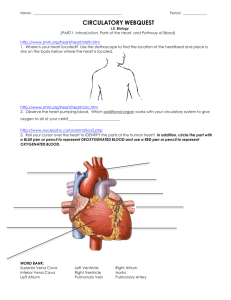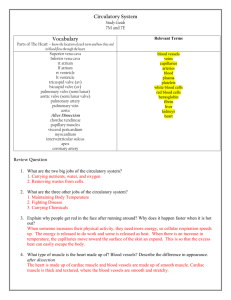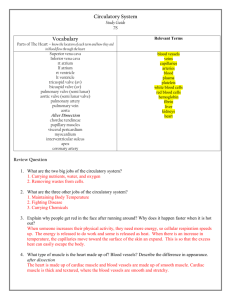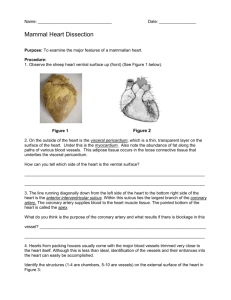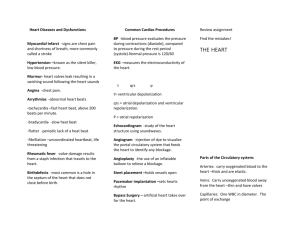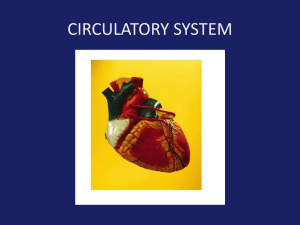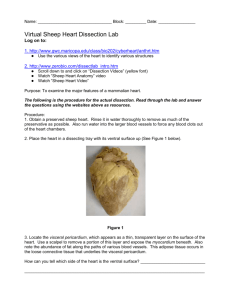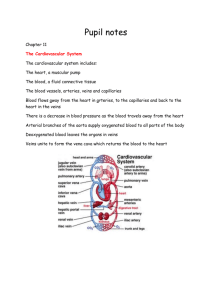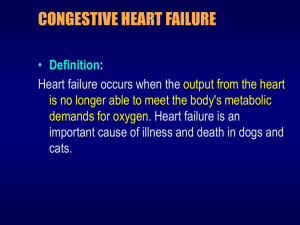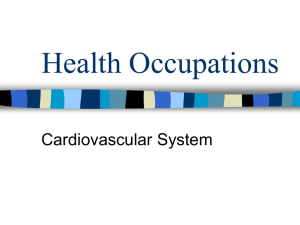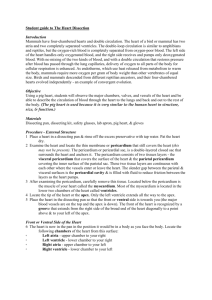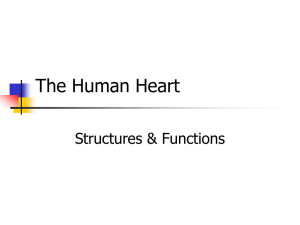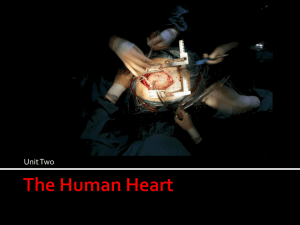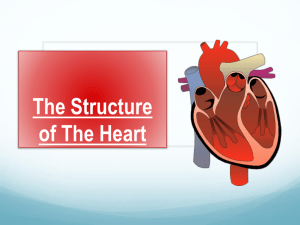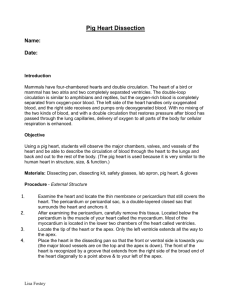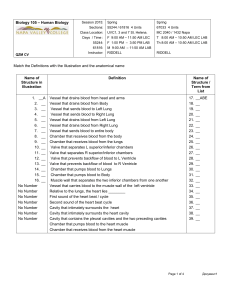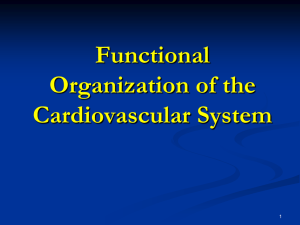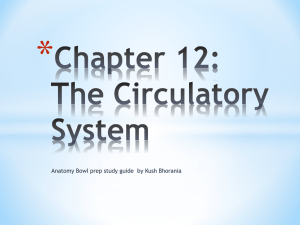Across - healthcaresciencemcghin
advertisement
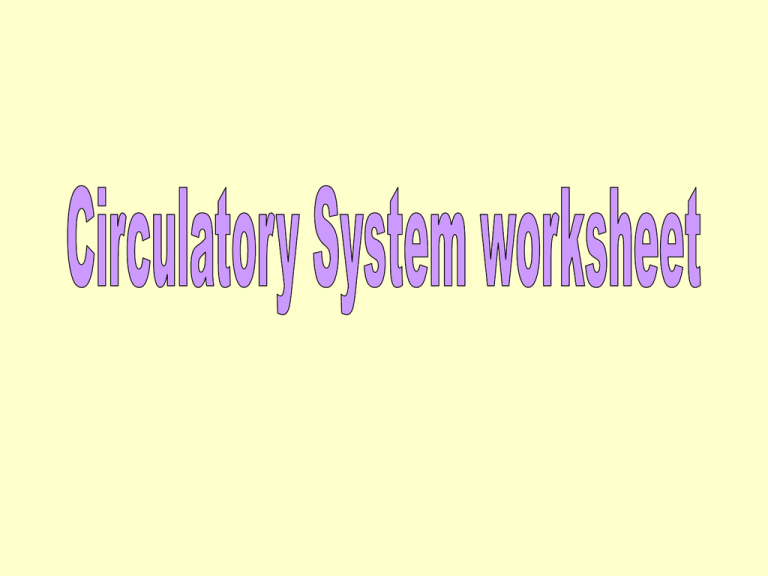
Across: 1. Blood vessel that carries blood back to the heart . 5. Valve between left ventricle and aorta 6. Muscular middle layer of the heart. 9. Double-layered membrane on the outside of the heart. 13. Blood cell required for the clotting process 14. Blood vessel that carries blood away from the heart. 16. Muscular wall that separates the heart into a right and left side. 17. Complex protein on the red blood cell. 19. Lower chamber of the heart. 2. Smooth layer of cells lining the inside of the heart. 3. Valve between the right ventricle & pulmonary artery. 4. Upper chamber of the heart. 7. Blood cell that carries oxygen & carbon dioxide. 8. Brief period of rest in the heart. 9. Fluid portion of blood. 10. Blood vessel that connects arterioles with venules. 11. Valve between the left atrium and left ventricle. 12. Blood cell that helps fight infection. 15. Period of ventricular contraction in the heart. 18. Tissue that flows through the circulatory system. • • • • • • • • • • • • A. pericardium B. myocardium C. endocardium D. septum E. superior vena cava F. Inferior vena cava G. right atrium H. tricuspid valve I. Right ventricle J. pulmonary semilunar valve K. pulmonary artery L. pulmonary veins •M. left atrium •N. bicuspid or mitral valve •P. aortic semilunar valve •O. left ventricle •Q. aorta 3. Describe what happens in the heart during diastole. Atria contract and push blood into the ventricles. 4. Describe what happens in the heart during systole. State where each ventricle sends the blood. right ventricle pushes blood into pulmonary artery so blood goes to the lungs, left ventricle pushes blood into the aorta so blood goes to all parts of the body. • 5. List the parts of the conductive pathway for electrical impulses in the heart. List the parts in correct order. ( SA) node, pathways in the atria, atrioventricular (AV) node, bundle of His, right & left bundle branches, Purkinje fibers 1 The SA node sets the rate and rhythm of your heartbeat 2 The SA node fires an impulse. The impulse spreads through the walls of the right and left atria, causing them to contract. This forces blood into the ventricles. 3 The impulse travels to the AV node. Here, the impulse slows for a moment before going on to the ventricles . 4 The impulse travels through a pathway of fibers called the HISPurkinje network. This network sends the impulse into the ventricles and causes them to contract. This forces blood out of the heart to the lungs and body. 5 The SA node fires another impulse. The cycle begins again . • 6. What is arrhythmia? How is it diagnosed? abnormal heart rhythm; cardiac monitors & electrocardiogram 7. Identify the following blood vessels • A. blood vessels that carry blood away from the heart: B. Blood vessels that carry blood back to the heart: • C. Blood vessels that connect arterioles with venules. • D. Largest artery in the body. • E. Two largest veins in the body. • F. Vessels that allow oxygen & nutrients to pass through to cells. • G. Smallest branches of arteries. • H. Smallest branches of veins. • I. Vessels that contain valves to prevent backflow of blood. • J. Most muscular & elastic blood vessels. 8. List 5 substances transported by the blood. 9. List 5 substances that dissolved or suspended in plasma. 10. Name the 3 main types of blood cells. State the normal count & the function of each type. Blood Cell Normal count; Per cubic millimeter of blood. Erythrocytes 4.5 to 5.5 million Leukocytes Thrombocytes Function Carry oxygen & carbon dioxide 5,000 to 10,000 Fight Infection 250,000 to 400,000 Aid in clotting process 11. What gives blood its characteristic red color? • Hemoglobin and the amount of oxygen present. 12. What is hemoglobin? What is its function? • Hemoglobin is a complex protein found on the red blood cell; and its function is to carry oxygen and carbon dioxide. 13. Identify the type of leukocyte(s) that performs the following function. phagocytize bacteria neutrophils &/or monocytes provide immunity for the body by developing antibodies. defend the body from allergic reactions lymphocytes produce histamine & heparin. basophils eosinophils 14. Name the following diseases of the circulatory system. Saclike formation of in the artery wall Inadequate number of RBC, hemoglobin, or both Dilated swollen veins A fatty deposit of the walls of arteries Disease characterized by failure of the bld to clot. High blood pressure Inflam. Of the veins w/formation of a clot aneurysm anemias Varicose veins atherosclerosis hemophilia hypertension thrombophlebitis Diseases cont’d Blockage in the coronary arteries of the heart Foreign substance circulating in the blood stream. Malignant disease with large numbers of immature WBC Myocardial infarction or heart attach. embolus leukemia JMcGhin
